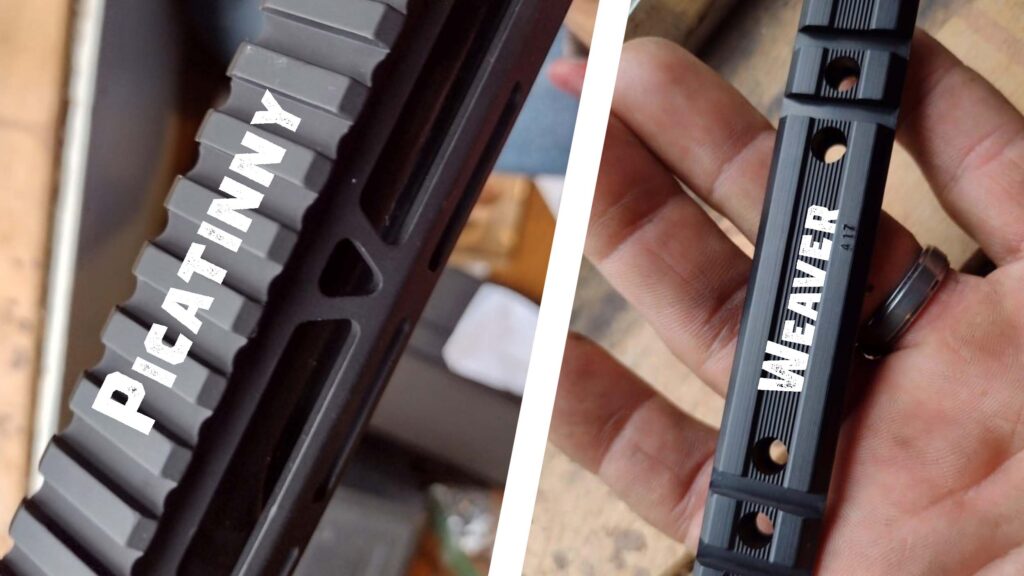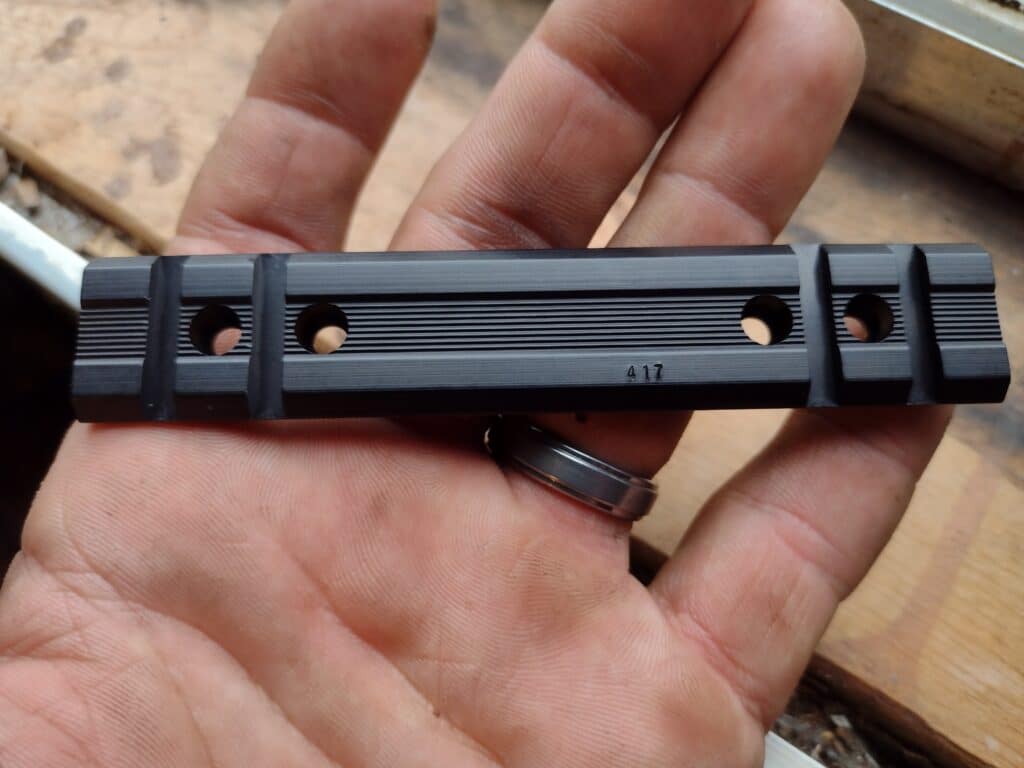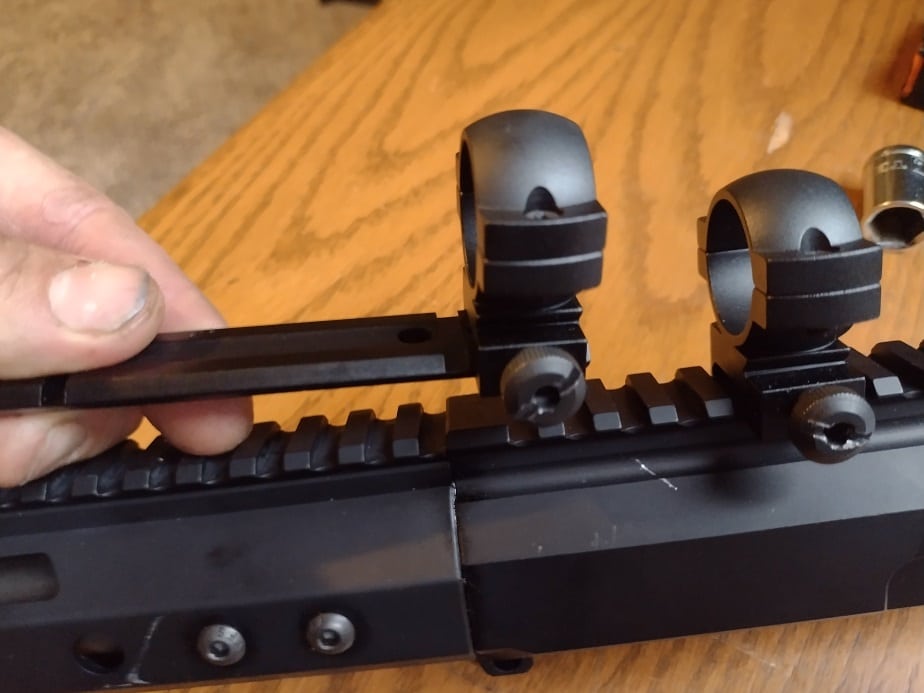Weaver vs Picatinny Rails: How to know which you have

At one point, I didn’t know the difference between the two and ran into trouble trying to put a scope on my rifle. I’ll help you understand the differences.
Picatinny accessories generally don’t fit on a Weaver rail, but Weaver accessories do fit on Picatinny rails. The civilian design of a Weaver rail has .18-inch cross slots that may not be regularly spaced. Picatinny rails are military-designed and have .206-inch cross slots spaced .394-inches apart.
There are some nuances to both designs. I’ll give you the lowdown, and also get into optic mounting tips.
Why Picatinny Rails are Different than Weaver Rails
Picatinny rails are different than Weaver rails simply because they were designed by two vastly different industries. The Picatinny rail was designed by the military, and it looks crude and tough. The Weaver rail was designed to look nice and to hold a scope firm.
The weaver rail was the first to come out. After the Weaversight company was founded in 1930, They developed a rail system to mount scopes onto rifles.
At the time, scopes were very expensive, and owning one usually meant you had some expendable cash. They were designed to be pretty and not take away from the looks of a well-shined hunting rifle.
Much later, in 1995, the US military standardized a rail system to use regularly spaced cross slots and named it the MIL-STD-1913 rail. it was later picked up by NATO and given the name STANAG 2324 standard. Because it was developed in the Picatinny arsenal, it’s known as the Picatinny rail. Sometimes abbreviated as Pic rail.
The Weaver rail looks a bit more like a piece of art, whereas the Picatinny rail looks more like a crude, tough tool. Both will hold up to a heavy rifle recoil, but the Picatinny rail gives a tougher hold.
The weak point of the Weaver rail system is the crossbar in the optic mount itself. Though hardly a weak point, the military decided to beef up the design. To be fair, war is a harsher environment than a deer hunt.
The military used larger cross slots because that meant they could now use an optic mount with a wider crossbar. That gave the design a bit more metal on metal to hold a scope in place.
Without a crossbar, the scope will just slide forward from recoil. The crossbar acts like a pin to hold the scope in place. The multiple cross slots on the Picatinny rail evenly spaced allows you to make standardized, incremental adjustments to fit a wide variety of optics and shooters.

Picatinny accessories will not fit on a Weaver rail
Picatinny-only accessories will not fit on a Weaver rail because the wide crossbar beneath the mount will not fit in the small cross slot of a Weaver rail. Picatinny-only optic mounts and scope rings must be installed on a Picatinny rail.
Looking at these pictures, you can see the Weaver rail has smaller slots. You just can’t make a Pic accessory fit a Weaver rail. Luckily for us, outside of the military, Picatinny-only accessories are uncommon.
The vast majority of all optics and scope rings are compatible with both designs. In fact, I recently bought a set of Picatinny scope rings that actually fit both. They weren’t true Picatinny accessories, But I wasn’t upset. You can use Picitanny accessories just fine, as long as you use good mounting techniques.
It’s the same as when installing something onto any firearm rail. Keep everything forward. What I mean is, Make sure the crossbar is all the way forward in the cross slot. if not, it will shuck forward and may loosen screws and bolts.
Both mounting systems have a bit of slop or “free wiggle” when the crossbar is in the cross slot. When tightening the bolts, barely finger snug them, then push the mounting accessory all the way forward (toward the muzzle) before cinching down tight.
Recoil forces everything to move forward. That’s why you are supposed to mount forward in the slots. the same applies to a flashlight or a laser. If it starts shucking forward, the movement may cause screws to loosen. The scope doesn’t have to be all the way forward in the rings because there is enough surface contact to hold it in place.
I’ve had it happen myself. My scope came loose and I went through a box of ammo trying to diagnose the accuracy issue I was having. Apparently, the scope was just moving around on me.

Weaver Accessories Fit on a Picatinny Rail
Weaver accessories have a thinner crossbar than Picatinny. That means Weaver accessories fit a Picatinny rail, just with more wiggle room before it is tightened. Weaver accessories are often marketed as universal because they work on both systems. Just keep the crossbar forward in the cross slots.
The main two reasons the Picatinny rail was developed by the military instead of them simply using the weaver rail, besides the fact that they re-invent everything, was to make it tougher and to make it more customizable.
The weaver system usually has less than an inch of adjustment back and forth. Depending on the individual shooter, sometimes you need to mount a sight further back or further forward to fit well.
Having more versatility also helped with the use of more than one type of optic. Many rifles with a Weaver mounting system can only fit a rifle scope. if you wanted to use a red dot, it may not fit. A lot of rifles, like the Ruger American, use a two-piece rail. A small red dot won’t fit across both rail pieces.

AR-15s vs Traditional Hunting Rifles
The Picatinny rail is of military design, so it’s usually on rifles that have more military or tactical look. Take for example the ever popular AR-15. Almost every AR-15 has a Picatinny rail on top of the receiver. I’ve never seen an AR that had a Weaver rail. It’s a style and standard that the market had come to expect. And, it makes sense.
The tactical style guns are meant to be used with a wide variety big sights and other accessories, all in varying positions on the gun. Most traditional hunting rifles have one or two positions you can mount a scope at, and it’s usually only an inch or less of difference.
The Weaver rail has been part of traditional hunting rifles for something like 80 years. To many, it’s the traditional choice and “part of” a complete hunting rifle. For the most part, these two rail designs stay in their own lane. Some Tactical rifle owners don’t know what a Weaver rail is, and some traditional riflemen don’t know what a Picatinny rail is.
Picatinny is Becoming Popular, But Weaver Still Looks Fancier.
Ever since the “Assault Weapons Ban” ended in 2004, the Picatinny rail has been mainstream. It’s been gaining ground every year. Now that the AR is considered America’s favorite rifle, it’s as common as a Weaver rail. But, it still looks crude, blocky, and rugged.
The main reason the Weaver rail is here to stay us that it looks nice on a fancy rifle. Go pick up a Weaver brand name rail and compare it to the rail on a nice AR-15. The Weaver rail has a smooth shiney finish and unnecessary art built into the design. If you want to have a rifle that’s also a pretty piece of art, the Picatinny rail would clash pretty hard with it’s blocky look and dull finish.
Tips for Mounting an Optic on a Weaver or Picatinny Rail
to mount a scope, you need the proper mounting hardware for your gun snd scope. You’ll also need a screwdriver that fits your screws, and something to hold your gun still while you work on it. It helps a lot to have a small bubble level and a torque screwdriver.
We’ve got a video here with lots of great tips.
Use a Gun Vise or Shooting Rest (bipods work too)
You need to have your gun still and level to begin the mounting process. Just setting it on the kitchen table isn’t going to work well. You need something to hold it somewhat steady. A gun vise is real nice to have, but I get by with my shooting rest.
I have one of those sighting-in rests that hold the gun up at two points. With a sandbag dropped over the rifle, it holds in place well enough so I can keep things level. MY ar-15 has a shooting bipod on it. I can use that to hold the rifle still for me.
Tighten Screws in a Crisscross Pattern
It’s usually advised to torque down the screws in the scope in a divergent pattern as you do with lug nuts on a tire. You also want to try and keep the top half of the scope ring straight. don’t tighten one side fully before going on to the other.
There will be a small gap between the top and bottom half of your scope rings. Keep that gap fairly even on both sides of each ring.
Blue Loctite, Maybe
Some experts recommend using a blue Loctite on screws that hold the rail in place. It is not recommended to use Loctite on the screws in your scope rings because it can actually lubricate the threads when wet, causing overtightening damage to the scope.
A number of gunsmiths use a thread locker like Loctite on screws. Most of the scope companies recommend against it. Basically, they’re tired of people breaking their scopes by over-tightening the scope rings, and Loctite makes it easier to overtighten them.
A Tourque Screwdriver Takes Away Guesswork
If you mount a scope without a torque screwdriver, you almost certainly overtightened it. I’ll say it again. When you use the proper 18 inch-pounds of torque, you’ll feel like it’s not tightened enough, but it is. Pretty much everybody who doesn’t use a torque screwdriver seriously overtightens the screws.
Buble Levels can make it Easier
A bubble level is an awesome tool to help mount a scope straight, Basically, you use it to make the gun itself straight, then use it again to make sure the scope is straight and square in the rifle. If your scope is on your rifle with a cant to the left or right, it will throw off your shots, and mess up the adjustments on the scope. Things just won’t work well.
Whether you use a Weaver or Picatinny for all this, it really doesn’t matter. Just use what came with your gun, or what you like.
